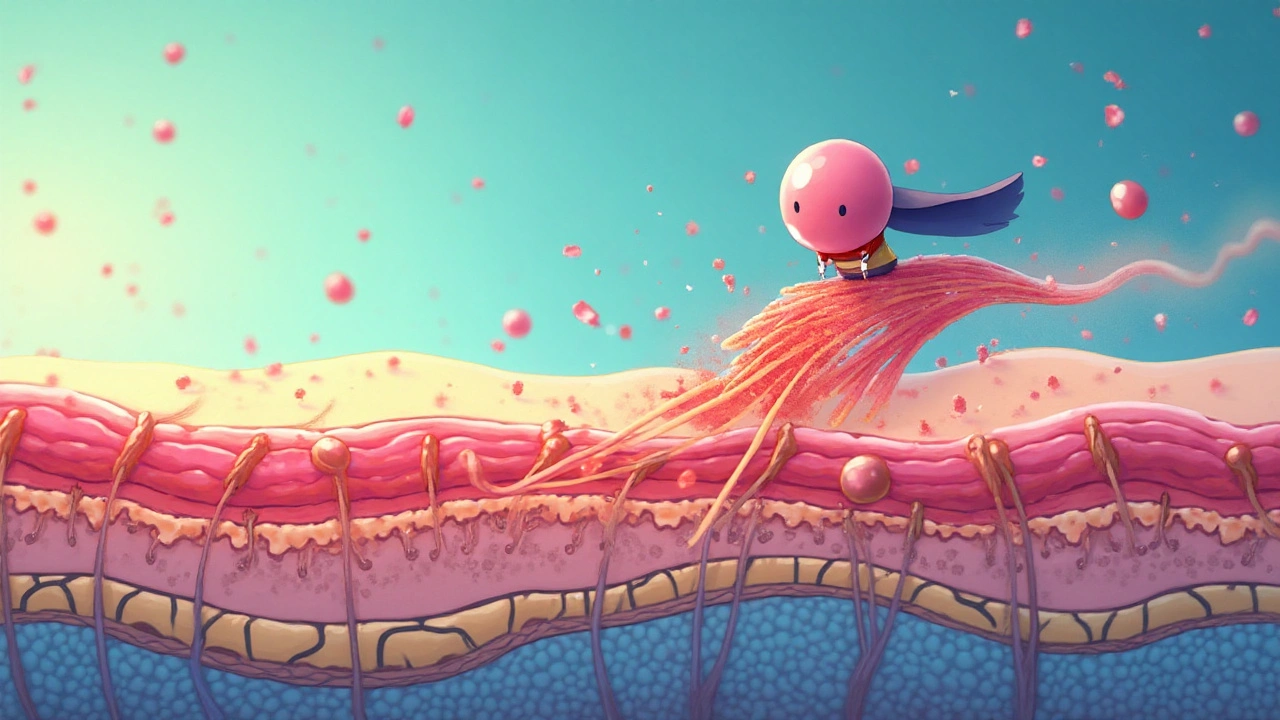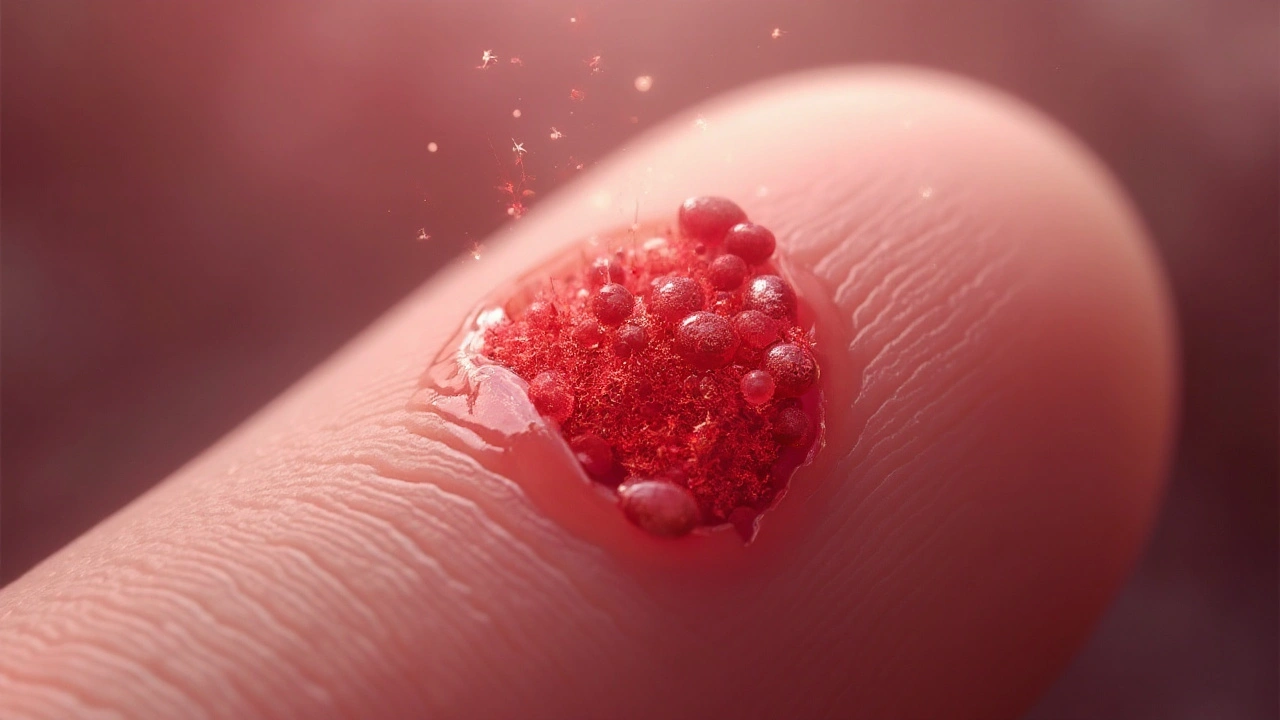Blood clotting is a physiological process that converts liquid blood into a solid plug, preventing blood loss after injury. It is the first line of defence that paves the way for the body’s repair crew to rebuild damaged tissue.
Quick facts you need right now
- Blood clotting starts within seconds of a cut.
- Two overlapping phases-primary and secondary hemostasis-work together.
- The clot forms a temporary scaffold for fibroblasts and new blood vessels.
- Nutrition, age, and medications can speed up or slow down the cascade.
- When clotting goes wrong, you get either endless bleeding or dangerous clots.
How the clot actually forms
When a vessel wall is breached, the body launches primary hemostasis. Tiny platelets rush to the site, stick to exposed collagen, and release sticky chemicals that make them clump together. This creates a soft platelet plug that buys time for the next stage.
Next up is secondary hemostasis, also called the coagulation cascade. A cascade of more than a dozen clotting factors (I, II, V, VII, VIII, IX, X, XI, XII, and protein C/S) activates one another like a line of dominoes. The end result is the conversion of the soluble protein fibrinogen into insoluble fibrin threads that weave through the platelet plug, solidifying it into a durable clot.
| Aspect | Primary Hemostasis | Secondary Hemostasis |
|---|---|---|
| Key Players | Platelets, collagen, von Willebrand factor | Clotting factors (I‑XIII), fibrinogen, thrombin |
| Time Frame | Seconds to minutes | Minutes to hours |
| Resulting Structure | Soft platelet plug | Rigid fibrin mesh |
| Triggers | Vessel injury exposing collagen | Platelet plug releasing phospholipids & tissue factor |
Why the clot is a launchpad for healing
The clot does more than just stop bleeding. It creates a moist, protected environment that keeps germs out while allowing growth factors such as platelet‑derived growth factor (PDGF) and transforming growth factor‑beta (TGF‑β) to accumulate.
These molecules call in the repair crew: fibroblasts migrate into the fibrin matrix, lay down new collagen, and pull the wound edges together. Meanwhile, new blood vessels sprout in a process called angiogenesis, delivering oxygen and nutrients that speed up tissue regeneration.
The link between clot quality and scar formation
A well‑structured fibrin mesh leads to orderly collagen deposition, which translates to a flatter, less noticeable scar. Conversely, a shaky clot-perhaps caused by low platelet count or inadequate fibrin-forces fibroblasts to work in a haphazard fashion, resulting in thicker, raised scars.
Research from the University of Melbourne (2023) showed that patients with a faster transition from fibrin to collagen healed up to 30% quicker than those with prolonged fibrin persistence.

Factors that tip the balance
- Age: Older adults produce fewer platelets and slower thrombin generation, extending the clotting timeline.
- Nutrition: Vitamin K, zinc, and omega‑3 fatty acids are essential cofactors for the cascade.
- Medications: Anticoagulants (warfarin, DOACs) blunt factor activity; NSAIDs impede platelet aggregation.
- Chronic conditions: Diabetes impairs fibrin cross‑linking, while liver disease reduces clotting factor synthesis.
- Lifestyle: Smoking damages endothelial cells, making it harder for platelets to adhere.
When clotting goes awry
Bleeding disorders such as hemophilia or von Willebrand disease cripple one or more steps in the cascade, leading to prolonged bleeding. On the flip side, hyper‑coagulable states-like Factor V Leiden mutation or prolonged immobilisation-push the system toward dangerous clot formation, which can block arteries and cause heart attacks or strokes.
Knowing the warning signs (unexplained bruising, frequent nosebleeds, or sudden calf pain) can prompt early medical intervention.
Practical tips to keep your clotting on point
- Eat a balanced diet rich in leafy greens (vitaminK), lean protein (zinc), and fatty fish (omega‑3).
- Stay hydrated; plasma volume drops when you’re dehydrated, making clots less stable.
- Limit alcohol intake - excess consumption hampers liver production of clotting factors.
- If you’re on blood thinners, discuss dosage adjustments with your doctor before surgery or major cuts.
- Manage chronic conditions - keep blood sugar in check and control blood pressure.
Related concepts worth exploring
Understanding inflammation helps explain why a mild, controlled inflammatory response is essential for clot maturation. Likewise, the extracellular matrix provides the structural backdrop against which fibrin and collagen interact.
Future posts will dive into how stem cells interact with the clot matrix and the emerging role of bio‑engineered scaffolds that mimic fibrin’s properties.

Frequently Asked Questions
How long does a blood clot stay in a wound?
A clot typically remains for 3‑7 days. As fibroblasts lay down new collagen, the fibrin mesh is gradually broken down by plasmin, allowing normal tissue to replace it.
Can I speed up clot formation?
Yes. Consuming vitaminK‑rich foods (spinach, kale), staying hydrated, and avoiding excessive NSAID use can help platelets and clotting factors work more efficiently.
Why do some cuts heal with a big scar?
A weak or irregular clot leads to chaotic collagen deposition. When the fibrin scaffold is unstable, fibroblasts produce uneven collagen bundles, resulting in a raised, visible scar.
Do anticoagulant medications affect wound healing?
They can delay the formation of the fibrin mesh, extending the time the wound remains open. This may modestly slow tissue repair, though the effect varies with dose and individual health.
Is it safe to apply heat to a fresh clot?
No. Heat can increase blood flow, destabilising the clot and causing re‑bleeding. Keep the area cool and protected for the first 24‑48hours.


Tara Timlin
September 22, 2025 AT 00:56Hey everyone! If you’re looking to boost your clotting game, make sure you’re getting enough vitamin K-from leafy greens like kale and spinach-and don’t forget zinc and omega‑3s. Staying hydrated helps keep plasma volume up, which gives your platelets a better playground. Also, try to limit NSAID use after a cut because they can mess with platelet aggregation. If you’re on blood thinners, a quick chat with your doctor about dosage before any major surgery is a smart move. Hope this helps you heal faster!
Jean-Sébastien Dufresne
September 23, 2025 AT 18:40Wow!!! This post is a masterpiece, folks, and it perfectly captures why our blood is the ultimate #1 defense system!!! 🇺🇸💪❤️, it’s all about that rapid plug, that fibrin fortress, and the unstoppable healing crew!!! Let’s all remember to eat our greens, stay hydrated, and keep our bodies in tip‑top shape!!! 😊👍
Patrick Nguyen
September 25, 2025 AT 12:28The cascade of clotting factors operates like a well‑orchestrated domino set, each activation leading seamlessly to fibrin formation. Proper nutrition and adequate hydration are essential to sustain this precise biochemical sequence.
Patrick Bread
September 27, 2025 AT 06:16Oh sure, just add a sprinkle of vitamin K and the whole wound heals instantly-because biology is that simple.
Fiona Doherty
September 29, 2025 AT 00:05This article ignores the real problem: most people don’t even know what platelet count they have.
Neil Greer
September 30, 2025 AT 17:53Yo, great breakdown! Just a heads up-make sure you’re getting enough vit K and zinc, that stuff really helps the clot do its thing. Also, stay off the ibuprofen if you can, it can slow the whole process down.
Fionnuala O'Connor
October 2, 2025 AT 11:41Keep your diet rich in leafy greens stay hydrated and watch your meds for optimal clotting
Christopher MORRISSEY
October 4, 2025 AT 05:30The interplay between primary and secondary hemostasis represents a quintessential example of physiological coordination.
Their subsequent actions create a seamless transition from vascular injury to stable clot formation.
Upon vascular injury, platelets adhere to exposed collagen through von Willebrand factor, forming a transient plug.
This initial response is indispensable, for it curtails hemorrhage within seconds.
Subsequently, the coagulation cascade is activated, wherein a series of proteolytic activations convert prothrombin to thrombin.
Thrombin, in turn, catalyzes the transformation of fibrinogen into insoluble fibrin strands.
The fibrin network interlaces with the platelet plug, thereby conferring structural rigidity to the nascent clot.
Simultaneously, embedded growth factors such as PDGF and TGF‑β are liberated, orchestrating the recruitment of fibroblasts.
Fibroblasts migrate into the fibrin matrix, synthesizing collagen and effectuating tissue remodeling.
Angiogenesis proceeds in parallel, delivering essential oxygen and nutrients to the repairing tissue.
The quality of the fibrin scaffold critically influences the organization of collagen fibers, which dictates scar morphology.
Nutritional status, particularly the availability of vitamin K, zinc, and omega‑3 fatty acids, modulates the efficiency of these processes.
Age‑related declines in platelet function and thrombin generation further underscore the importance of systemic health.
Therapeutic interventions, such as judicious use of antiplatelet agents, must balance hemostatic efficacy with the risk of thrombosis.
Clinical observations consistently demonstrate that optimized clot formation correlates with accelerated wound closure and diminished scar formation.
Consequently, a holistic approach encompassing diet, hydration, and vigilant management of comorbidities is paramount for favorable healing outcomes.
Adam O'Rourke
October 5, 2025 AT 23:18Oh, because adding extra vitamin K will magically turn you into a superhero healer 😏
Mary-Pat Quilty
October 7, 2025 AT 17:06In the grand theatre of life, the humble clot takes centre stage, weaving a tapestry of flesh and fate-if only we’d give it the applause it deserves, like, seriously, feed it some kale and stop the drama!
Patrick McGonigle
October 9, 2025 AT 10:55Ensuring adequate intake of vitamin K, zinc, and omega‑3 fatty acids, maintaining proper hydration, and reviewing anticoagulant therapy with a healthcare provider are practical steps to support optimal clot formation and wound healing.
Keisha Moss Buynitzky
October 11, 2025 AT 04:43It is with sincere empathy that I acknowledge the challenges faced by individuals navigating the complexities of hemostasis; please be assured that a balanced regimen of nutrients, vigilant medical oversight, and compassionate self‑care can substantially ameliorate the wound‑healing trajectory.
Shivam yadav
October 12, 2025 AT 22:31Dear reader, I appreciate the comprehensive overview and would like to add that regular moderate exercise can also improve circulation, which in turn supports the delivery of essential nutrients to the clotting site.
pallabi banerjee
October 14, 2025 AT 16:20Let’s remember that everyone’s body responds differently; if you notice slow healing, consider a gentle check‑up with your doctor and perhaps a modest increase in leafy vegetables to support your unique healing journey.
Alex EL Shaar
October 16, 2025 AT 10:08Honestly, this piece reads like a sloppy cookbook for blood – half‑baked, riddled with jargon, and missing the damn point. The author throws around “fibrin mesh” and “angiogenesis” without any real context, making the whole thing a pretentious mess. Plus, the grammar is all over the place; “blood clotting starts within seconds of a cut” – wow, groundbreaking insight! If you wanted to actually help someone, maybe stop flexing your scientific buzzwords and give clear, actionable advice. Also, the list section is a nightmare of inconsistent bullet styles – get your act together.
Anna Frerker
October 18, 2025 AT 03:56Nice article, but it could use a stronger emphasis on American dietary guidelines.
Julius Smith
October 19, 2025 AT 21:45👍💉🩸